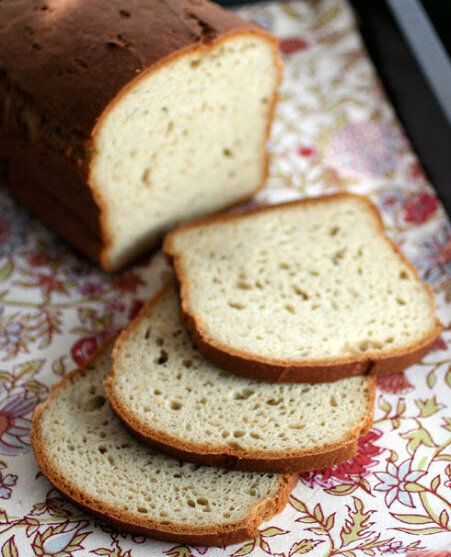
Don’t believe that a gluten-free, soy-free, vegan cupcake can be delicious? Then you’ve obviously never visited Bunner’s Bake Shop, a Toronto bakery that’s found a huge audience for its goods. Now Canadians all over the country can enjoy their sweet and savoury baked items, thanks to the release of their first cookbook, Bunner’s: Simple & Delicious Gluten-Free Vegan Treats.
Ashley Wittig is a long-time baker who learned to adapt many of her favourite recipes when she adopted a vegan diet. Along with her partner Kevin MacAllister, who is also vegan, she opened Bunner’s in Toronto’s Junction neighbourhood in 2010. With no advertising, the bakery has become a local favourite — Wittig’s recipes have been featured in publications like the National Post, and its goods have been named some of the best in the city. And they're all made without animal products like butter and eggs, soy, gluten-containing products like wheat, and nuts or peanuts.
"Our main dream was to have a bakery that was amazingly delicious and accessible to everyone, no matter your dietary restrictions,” Wittig said of Bunner’s. "Our substitutes for things like dairy and eggs are often superior in texture and flavour for our uses. We avoid gluten, soy, and nuts in an effort to be as allergy friendly as possible."
In April, Wittig and MacAllister released their first cookbook, Bunner’s, which contains some of their shop favourites, including cinnamon buns, sweet potato-cranberry muffins, and veggie pot pie. Now the pair are working to open a second location of their bakery — they’ve just signed a lease for a spot in Toronto’s Kensington Market — and Wittig is at work on the next cookbook.
“Our main goal is to make traditional baked goods that are as accessible as possible, and to show everyone that vegan and gluten-free baking is just as delicious, if not more,” Wittig said. "The proof is in the pudding! We've been voted best muffin in the entire city, best dessert shop, our brownie was featured as one of the most delicious things to eat in the city ... and the list goes on! It doesn't matter that it's vegan and gluten free, it's just plain delicious!"
Check out three recipes from the cookbook below, and read our seven reasons why a restricted diet can be frustrating — but admittedly, a lot less frustrating with spots like Bunner’s around.










Mac & Cheese
Makes enough for 2 hungry people, or 4 sides
This dish is so simple, it’s almost too good to be true. It’s ideal for a weeknight meal: the sauce is a snap to make, and if you’re in a real rush, you don’t even need to bake it. Throw in some chopped greens like kale or broccoli, or add a smoky kick with a little bit of chopped chipotle. This dish can also be doubled easily if you have a bigger troop of tummies to fill.
8 ounces brown rice elbow pasta
2 tablespoons Earth Balance Buttery Sticks
1¼ cups coconut milk beverage
6 tablespoons nutritional yeast flakes
1 tablespoon fresh lemon juice
2 teaspoons Dijon mustard
1½ teaspoons onion powder
1½ teaspoons garlic powder
1 teaspoon sea salt
Ground black pepper
1 tablespoon arrowroot starch
1 cup Daiya mozzarella-style shreds
1 15-oz can puréed butternut squash (or 1½ cups roasted and puréed squash)
½ cup gluten-free bread crumbs
½ to 1 teaspoon paprika
Preheat the oven to 400°F. Bring a large pot of salted water to boil. Add the pasta and cook according to the package directions.
In a medium saucepan over medium-high heat, melt 1 tablespoon butter. Add the milk, nutritional yeast, lemon juice, mustard, onion powder, garlic powder, salt, and pepper. Whisk briskly to combine. Slowly whisk in the arrowroot starch.
Simmer until the sauce begins to thicken, about 5 minutes. Add the mozzarella shreds and slowly whisk until melted, about 5 minutes. Add the squash and whisk until everything is combined and heated through. Add the cooked pasta to the sauce, stirring gently to combine. Season to taste.
Pour the mixture into an ovenproof baking dish—either a 9-inch (round) glass pie plate or a 9- × 9-inch square dish works well.
In a saucepan, melt the remaining butter. Add the bread crumbs and toss to coat well, then sprinkle evenly over the pasta. Top with a sprinkling of paprika. Bake for 15 minutes or until the sauce begins to bubble. Serve hot with a side salad and ketchup or hot sauce.
Cinnamon Buns
Makes 6 cinnamon buns
Cinnamon buns, a.k.a. smell paradise, are probably the treat we hear the most talk about. We always sell a lot of these cinn-ful little sweethearts, but never more than we do on Christmas Eve. People buy them by the dozen to reheat in the oven on Christmas morning, giving them something to look forward to after all the gifts are opened and the stockings are inside out. You can make these the night before and store them, unbaked, covered in plastic wrap in the refrigerator. Bake as directed the next morning, letting them come to room temperature before baking.
Tip: Roll up your sleeves for this one! This recipe is a bit involved, so I strongly encourage, nay, insist, that you read the recipe through before you start. This is so you can have a little foresight into what you’ll be doing and hopefully avoid any mishaps.
Buns
3¾ cups Bob’s Red Mill gluten-free all-purpose flour
1⁄3 cup organic sugar
1 tablespoon xanthan gum
1 teaspoon gluten-free baking powder
½ teaspoon sea salt
1 tablespoon regular active dry yeast
½ cup lukewarm water
¾ cup canned coconut milk
¼ cup Earth Balance Buttery Sticks (½ stick), melted
¼ cup unsweetened applesauce
2 tablespoons + 1½ teaspoons canola oil
1 teaspoon apple cider vinegar
1 teaspoon vanilla extract
Cinnamon Sugar
¼ cup organic sugar
¼ cup Sucanat
2 tablespoons ground cinnamon
1 tablespoon Earth Balance Buttery Sticks, melted
Sauce
¼ cup Earth Balance Buttery Sticks (½ stick), melted
½ cup Sucanat
¼ cup agave nectar
¼ cup canned coconut milk
1 teaspoon vanilla extract
¹/₈ teaspoon sea salt
Topping
Cream Cheese Frosting
½ cup Earth Balance Buttery Sticks (1 stick), at room temperature
½ cup Tofutti non-hydrogenated vegan cream cheese
3½ cups organic powdered sugar, sifted
1 teaspoon vanilla extract
2 to 3 tablespoons canned coconut milk or soy creamer
Using a stand mixer or hand mixer, cream together the butter and cream cheese until smooth and fluffy.
Slowly add the sugar, mixing well. Add the vanilla and then 2 tablespoons coconut milk, adding more as needed to achieve a nice, spreadable consistency.
Whip the frosting for several minutes, until fluffy. Use immediately or store in the refrigerator. If refrigerated, bring to room temperature and give it a good turn with a frosting spatula or butter knife before using.
Preheat the oven to 350°F. Have a 9-inch ungreased cake pan ready (the sides should be about 2½ to 3 inches high).
Melt all the butter for the recipe — a total of ½ cup + 1 tablespoon. Set aside.
For the buns: In a large bowl, sift together the flour, sugar, xanthan gum, baking powder, and salt. Whisk to combine.
In a small bowl or measuring cup, add the yeast to the warm water (it should feel just slightly warmer than the inside of your wrist). Set aside to let the yeast proof—about 10 minutes or until the yeast is frothy and bubbly.
In a medium bowl, whisk together the coconut milk, melted butter, applesauce, oil, vinegar, and vanilla.
Once the yeast has proofed, stir the yeast mixture into the wet ingredients and then add the combined wet ingredients to the dry ingredients. Stir thoroughly with a spatula until a sticky but firm, well-blended dough is achieved.
For the cinnamon sugar: In a medium bowl, combine the sugar, Sucanat, and cinnamon. Stir in 1 tablespoon melted butter and set aside.
For the sauce: In a small bowl or measuring cup (with a spout for easy pouring), combine the remaining ¼ cup melted butter, Sucanat, agave nectar, coconut milk, vanilla, and salt. Set aside.
Grab two big sheets of parchment paper (about 12 inches long). Spray one side of each sheet with canola oil. Turn out the dough onto one of the oiled sheets, then spray the dough with canola oil. Form the dough into a rough rectangular shape. Place the other sheet of parchment paper over top, oiled side down. Using your hands or a rolling pin, flatten the dough into a rectangular shape, about 8 × 10 inches. Slowly peel back the top parchment paper and set aside.
Sprinkle the cinnamon sugar onto the dough and, using your hands, spread it out to cover the dough edge to edge.
Using oiled or wet hands, slowly roll up the dough starting from a shorter side of the rectangle.
Cut the dough roll in half using a sharp knife that has been lightly oiled with canola oil, then cut each half into three rolls. Place the rolls in the cake pan, cut sides up. Pour the prepared sauce evenly over top.
Let the rolls rise for about 10 minutes (don’t worry if nothing drastic happens; gluten-free goodies tend to rise mostly in the oven), then bake for 20 minutes or until the tops are firm and a bit golden and the sauce is bubbly. If the sides of the cake pan aren’t very high, place a baking sheet beneath the cake pan to catch any sauce that bubbles over.
Remove the buns from the oven and let rest for 5 minutes, then flip the cake pan upside down onto a baking sheet or plate. Using a thin, sharp knife, gently separate the buns. Place them on a serving plate before finishing with cream cheese frosting.
Chocolate Chip Cookies
Makes 18 cookies
These cookies were one of my first and biggest successes in the kitchen, and one that I’m still so proud of today. These cookies are versatile size-wise. You can make them huge or you can shrink them down to little bite-size cuties and they will still turn out. Simply adjust the baking time by a few minutes, give or take, and let visual cues tell you when they’re done (they should be a warm golden brown).
2½ cups brown rice flour
½ cup potato starch
2 tablespoons arrowroot starch
1 teaspoon gluten-free baking powder
1 teaspoon baking soda
1 teaspoon xanthan gum
1 teaspoon sea salt
¾ cup + 1 tablespoon organic sugar
¾ cup agave nectar
1⁄3 cup melted coconut oil
2 teaspoons vanilla extract
1 teaspoon organic blackstrap molasses
2⁄3 cup vegan semi-sweet chocolate chips
Preheat the oven to 325°F. Line two baking sheets with parchment paper.
In a large bowl, sift together the flour, both starches, baking powder, baking soda, xanthan gum, and salt. Whisk to combine.
In a medium bowl, whisk together the sugar, agave nectar, oil, vanilla, and molasses.
Add the wet ingredients to the dry ingredients and mix well using a spatula. Fold in the chocolate chips until evenly distributed.
Using your hands, roll the dough into golf-ball-size pieces and place on the prepared baking sheets. Press down to flatten each ball to about ¼ inch thick and 2½ inches in diameter, being mindful to keep them spaced about 1 inch apart.
Bake for 12 to 15 minutes, until golden. Let sit on the baking sheets for at least 20 minutes, to firm up. Transfer to a cooling rack to cool completely, or eat them all right away.
Recipes from Bunner’s: Simple & Delicious Gluten-Free Vegan Treats by Ashley Witting & Kevin MacAllister ©2014. Photography by Kevin MacAllister. Published by HarperCollins Publishers Ltd. All rights reserved.
Also on HuffPost
